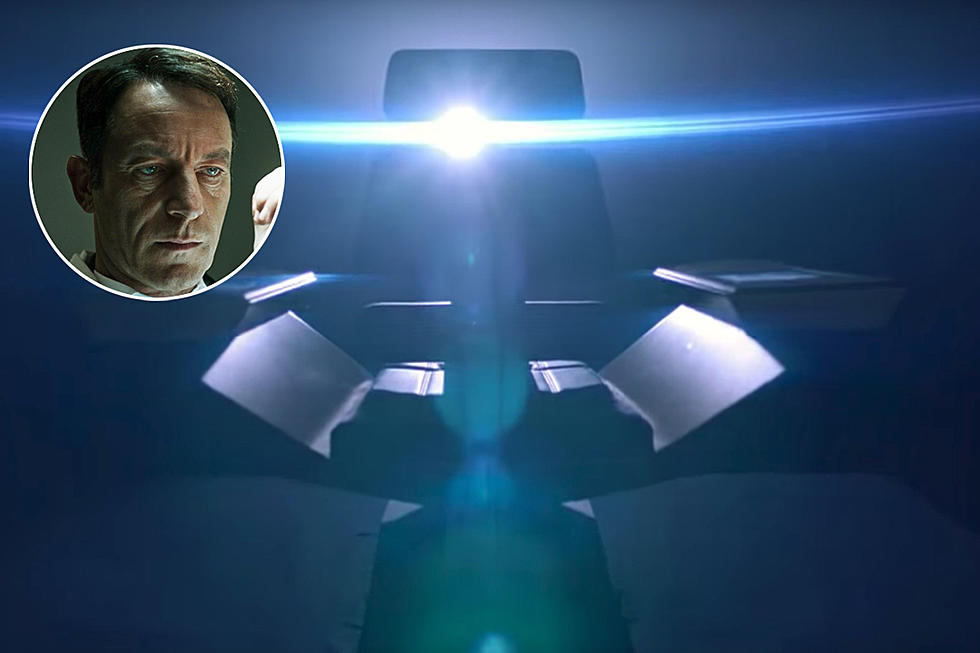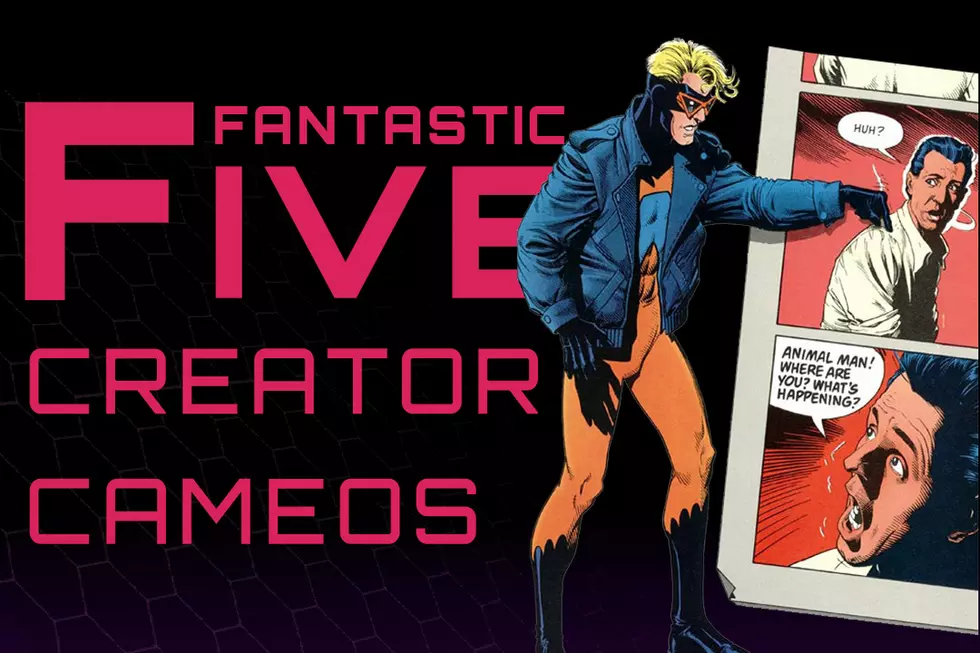
A Navigational Guide To 45 Years Of ‘Star Trek’ Comics
The hit film Star Trek Into Darkness is now available (as a digital download; the disc gets released in a couple of weeks), and you can stream the entirety of The Original Series, The Next Generation and more on Netflix and through other services. But what if you want more; what if you want the adventures of Captain James T. Kirk, Mister Spock, Doctor Leonard McCoy and that one redshirt who’s probably going to die before the cold open is over in your favorite four-color format?
The core storytelling element of Star Trek -- a group of heroes in brightly-colored costumes battle thinly-veiled analogues of Russia, China and other places while exploring the cosmos and teaching everyone lessons -- seems like it would be perfect for comics. And it is, and there are some good ones out there. Unfortunately, digging through the back-issue bins and the spotty collections that are available can be challenging, and that’s why I’m here to help you out with this navigation guide to 45 years of Star Trek comics.
The Gold Key Era (1967 - 1978)
Western Publishing's Gold Key imprint had the first Star Trek comic book license and boy, most of these are just out-and-out stinkers; generic kid-friendly sci-fi adventure yarns that lack anything close to the themes and characters that make the series what it is. In the first issue, they discover a planet where carnivorous plants are at the top of the food chain and they have enslaved intelligent animals to feed upon. James T. Kirk’s solution? Destroy the planet and all life on it. That’s right; he doesn’t just break the Prime Directive. He commits genocide.
Not even respected writers like Len Wein and Arnold Drake managed to do much more than crank out goofy hackwork in later issues. There’s a bit of amusement to be had in sequels to stories like “Metamorphosis” and the return of the Guardian of Forever, but only a bit.
While some stylization is a good thing in a licensed comics (one only need to look at the greatness of Frank Miller and Walt Simonson's Robocop Versus Terminator for proof of that), the fact is that original series artist Alberto Giolitti had never actually seen the show -- only publicity photos. In fact, he didn't have a photo of James Doohan, so he just drew a generic white guy for Chief Engineer Montgomery "Scotty" Scott for the first handful of issues. In fact, outside of Spock actor Leonard Nimoy’s makeup artist, nobody fared particularly well under Giolitti's pen, even if he drew a bitchin' Enterprise that shot fire out of its nacelles. Later artists followed up in that bland, ineffectual Gold Key style that has made the vast majority of their licensed comics the high point of no one’s collection.
All of this is particularly disappointing once you consider how gorgeous and enticing a lot of the covers for Gold Key’s run are. I’m pretty sure the publisher had to have been sued by at least one indignant fan who actually bothered to open up and read what was inside.
I’ve spent years trying to like these comics and failing; clockwork plotting and out-of-character dialogue sucks any enjoyment I'd normally get from goofy moments and … interesting artistic choices.
Marvel, Part I (1979 - 1981)
With the hype surrounding 1979's Star Trek: The Motion Picture, Marvel made its move to secure the license. Star Wars had basically saved the publisher and everyone liked Star Trek, right? It must have seemed like a no-brainer. It’s sad that the cerebral science fiction film's adaptation (with art by Dave Cockrum and Klaus Janson) is the creative high point of a series that was hamstrung by licensing restrictions. Marvel creators could only use characters shown in the film and were required to avoid any mention of what happened during the five-year mission of the original television series. You want a sequel to “City on the Edge of Forever?” Too bad, fanboy.
For sheer camp value, though, issue #4, "The Haunting Of Thallus," is worth checking out. It features an appearance from Marvel Comics' version of Dracula and he puts down a righteous smackdown on the crew.
I think we can agree that this is exactly the sort of thing that comics needs more of, period. Sadly, that wasn’t to be the case; Martin Pasko wrote the majority of these issues and with a series of artists that included Luke McDonnell and Gil Kane provided an updated version of the Gold Key model of the Trek story. Issue #18, the final installment, was penned by J.M. DeMatteis and features pirates, a giant robot, and a shirtless James T. Kirk in the opening splash; irritatingly, it’s somehow more generic than the rest.
DC Comics: A Story In Two Volumes (1982 - 1986)
Two years after Marvel ceased its Star Trek comic and bolstered by the success of Star Trek II: The Wrath Of Khan, DC Comics moved in. Thanks to the sharp editorial and quality control that helped foster the company’s 80s renaissance, they managed to publish the best Star Trek comics yet. Unlike Marvel, DC had free rein to use any and all of the established Trek mythos. With February 1984's "The Wormhole Connection," the publisher began stories set after the events of Star Trek II and leading into Star Trek III. This was the first time that a Star Trek comic actually felt like it should, even if you can feel Mike W. Barr, Tom Sutton and Ricardo Villagran learning a bit as they go.
Things got interesting once The Search for Spock came out and the trinity of Kirk, Spock and McCoy were reunited for a while. With "The Mirror Universe Saga" (which is available in an out-of-print but inexpensive trade paperback collecting issues #9-16), things kicked into high gear with a rollicking adventure where dimensions were hopped, Enterprises were destroyed (again) and an intrepid reporter saved the day. It was after this arc that James T. Kirk was given command of the Excelsior for an extended shakedown cruise. (After all, flying around in a captured Klingon Bird of Prey is a little…y'know. Something.)
One thing that really differentiated DC's approach from previous efforts was the strong supporting cast. With the original crew having to stay fairly static between films (to the point where they put Spock in charge of his own ship so he was off-screen most of the time), it was up to characters like Bearclaw, Bryce and the Klingon defector Konom to handle the actual drama.
Writers would change, but Sutton and Villagran remained the regular art team during first volume of DC's Trek series, taking breaks only when a movie adaptation or something like that demanded their attention. While the art is anything but remarkable -- Sutton was known for horror more than anything else and Villagran's inks were overpowering -- that consistency is one of those things we just don't see that often nowadays.
Trek novelist Diane Duane was responsible for a pair of very good stories from the first volume of DC's Star Trek. The two-parter "Double Blind" (issues #24-25) features two races -- one a group of fierce-looking Cthulhus, the other a literal group of talking house cats -- who both claim the Excelsior in a story that we can't let be discovered by the Internet. There's a lot of character-driven humor and heart in "Double Blind," and it's just as much fun as "The Trouble With Tribbles" or "A Piece of the Action."
Duane's other major contribution, issue #28's "The Last Word," is a McCoy-centric done-in-one that deals with death in the crew, something that Trek has generally avoided discussing much. Special note should be made of Gray Morrow's evocative art in this issue; he captured likenesses remarkably well while avoiding the stiffness that tends to accompany work that looks too on-model.
With Mike Barr stepping down as the regular writer, Len Wein took over after a series of fill-ins and helped guide the book to Star Trek IV: The Voyage Home. While this meant he was stuck with the task of explaining how Spock reverted to the "LDS"-addled spaceman we see in that film along with other bits of housekeeping, he managed to wrap things up fairly well, proof that he’d come a long, long way since his Gold Key material. Maybe, you know, writing a buttload of other comics helped.
After the fourth movie, things saw a notable dip in quality with sequels that nobody asked for ("The Apple"? Really?). Thankfully, Peter David came on board and began applying some of the same talent he's since demonstrated in comics like X-Factor while tackling the large cast of the series. In the space of a little under a year, there's a bachelor party, a massive space battle, a wedding, a trip to Dante's Inferno, the stabbing of James T. Kirk and the return of a now-reformed Finnegan, all done with a writerly, warm grace that the series had lacked before.
David also did a sterling job on Star Trek Annual #3, a story drawn by Curt Swan (with inks by series regular Ricardo Villagran) that focused on the great love of Scotty's life. (No, it's not the engine room. He likes girls, too. Just not as much.)
However, with Star Trek V: The Final Frontier, things changed... and not for the better. Considering the quality of that filmic effort, that should be nothing like a surprise.
Paramount handed down a decree that said the comic's supporting cast had to go and with them, the art team of Sutton and Villagran. The series was rebooted with a second volume. Peter David continued scripting through the first year and change, but even with his witty repartee and ability to work within the constrictions, it was obvious that the wind had been sucked out of the sails. James Fry and Arne Starr's art, while having a cartoonish appeal, also had the unfortunate effect of making the crew look slightly surprised at all times. Things that should have been fun, such as "The Trial of James T. Kirk," in which our captain has to answer for his many, many violations of the prime directive and other Federation statutes, seemed toothless.
Later writers like novelist Howard Weinstein tried their best, but the series became more episodic and lost a lot of the forward momentum that made the first volume stand out. Yes, there were sequels to episodes and fan favorite Wrath of Khan survivor Saavik rejoined the crew, but it became the one thing Treknever should be: just a product, and a boring one at that.
One oddity in DC's Volume Two era that stands out is the graphic novel Star Trek: Debt of Honor, written by Chris Claremont and drawn by Adam Hughes with Karl Story on inks. As you can probably imagine, it's over-scripted by a sizable percentage, with a core story obscured by pointless name-checking, unnecessary references and the need to explain everything as it happens. (Not to mention the accents. The accents, people.)
That said, Hughes does stellar (no, that is not a pun) work and not even Bob Pinaha's word balloons can’t do much to temper the glee at seeing one of comics' masters of likenesses tackle the crew of the Enterprise.
Marvel, Again (1997 - 1998)
By the time DC's second volume had wound down in 1996, the focus in Star Trek licensing was firmly on the Star Trek: The Next Generation characters and beyond. Only the quarterly Star Trek Unlimited featured stories set during The Original Series (Early Voyagesfeatured Captain Pike and the crew of the Enterprise before Kirk) and, for the most part, these were pretty typical for Marvel comics published the late 1990s: not very good.
The exception that proves the rule here is Star Trek Unlimited #3's "Message In A Bottle," written by Dan Abnett and Ian Edgington with Mark Buckingham and Kev Sutherland providing (occasionally photo-referenced, but still very serviceable) art. This story manages to echo "The Galileo Seven" and "The Immunity Syndrome" without aping them entirely while giving us a look at Lt. Uhura doing something besides operating the switchboard.
It's exciting, puts an underappreciated character front and center (this was before Tumblr, remember) and makes you want more in the same vein. Sadly, that wasn't to come.
(I know what you're thinking at this point: "Why haven't they mentioned the Star Trek/X-Men crossover?" That's because it's out-and-out terrible. Don't act like it's not. You say "X-Men and Spock! Hanging out! There are two Doctor McCoys!" and I say "Scott Lobdell wrote it.")
The Trek license proved to be too expensive to maintain and Marvel canceled all of their tie-in series simultaneously, an act that I’d like to think of as a mercy killing.
WildStorm (1999 - 2002)
DC Comics got its third chance at Star Trek when the license was granted to its recently-acquired WildStorm imprint. Like Marvel, WildStorm focused its efforts on TNG, DS9 and Voyagerfor the most part with only a few one-shots and special featuring the original series crew. The less said about these, the better, and not just because my editor is giving me the stinkeye about how long this piece is running.
Tokyopop (2006 - 2008)
Perhaps best known for scores of unfinished series and underpaid creators, American manga publisher Tokyopop released three volumes featuring short stories starring the original Star Trek crew in the style called "Amerimanga," invented by someone who should probably be dragged out into the street and shot. Despite the overall goofiness, there's some charm to be found these amateurish productions. David Gerrold (who scripted the classic "The Trouble With Tribbles" episode) was paired with Don Hudson in a story that features Captain Kirk seducing a space teddy bear.
For this alone, I thank everyone involved in this effort.
IDW Publishing (2007 - Present)
IDW obtained the license and started doing pretty well by it, with one-shots and miniseries focusing on the original series. A lot of these have been by-the-book affairs that don’t do much beyond letting the reader feel like they’ve seen a comics adaptation of an episode they somehow missed, but there’s still quality to be found in stories like the DC Fontana-scripted "The Enterprise Experiment."
Strangely enough, noted comics curmudgeon John Byrne's done some of his best work of the last decade and change on these titles, with Leonard McCoy: Frontier Doctor and an Assignment: Earth series that catches readers up with original series guest star Gary Seven. The former lets us see some of the nooks and crannies of the Federation while filling us in on how the title character earned that amazing beard between the end of the TV series and the first film. The latter follows up on the stealth pilot episode from the original series and it amounts to a fun, pop-tastic American take on Doctor Who. (That means you won’t fall asleep during it and wonder what the hubbub was about.)
Both of these series have been collected in Star Trek: The John Byrne Collection, an oversized hardcover that also collects his Romulan stories and other odds and sods.
Also worth mentioning is Chris Roberson and Jeffrey and Philip Moy's Star Trek/Legion of Super-Heroes crossover from 2011-2012, a six-part miniseries that's available now as a collected edition. While the Marvel crossover suffers from being a product of its time of publication, ST/LOSH features Roberson evoking a distinctly 1980s superhero comic vibe, with the two teams having a misunderstanding before teaming up to escape an alternate dimension where the Federation has been dominated by an emperor whose identity is just one huge orgasm for a certain sort of fan.
(I am that sort of fan. I have no pride.)
IDW's efforts over the last couple of years have been understandingly focused on an ongoing set in the Abramsverse established in the 2009 Star Trek movie reboot, but there’s a strangely enticing John Byrne comic on the horizon -- a photocomic sequel to the second pilot, “Where No Man Has Gone Before.”
It’s due to come out as an Annual this December and I hope this means that we’ll be seeing more oddities and interesting things of this nature coming out of IDW. After all, with 45 years of stories set in that universe, it still occasionally feels like the surface has just been scratched.
Note: Every Trek comic published prior to Tokyopop (including the book-and-record sets aimed at kids with art by Neal Adams and Russ Heath among others) is available in the PDF format on GIT Corp’s Star Trek: The Complete Comic Book Collection.
More From ComicsAlliance

![When Everything Is Pink, Nothing Is Pink: Sarah Stern On Color And Creativity [Interview]](http://townsquare.media/site/622/files/2017/03/Cindersong-feat.jpg?w=980&q=75)




![Mezco’s One:12 Collective Makes Marvel and DC More Memorable Than Ever [Toy Fair 2017]](http://townsquare.media/site/622/files/2017/02/IMG_2587.jpg?w=980&q=75)


